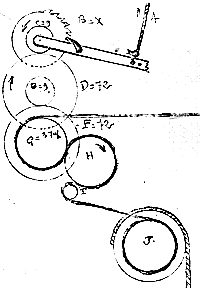- Home
- Resurrection ▾
-
Learn ▾
- Free library
- Glossary
- Documents
- Initiation
-
Shaped fabrics
- Introduction
- Popularization
- Definitions
- Le métier de façonné
- Principes du façonné
- Mécaniques de façonné
- Le jeu des crochets
- Les cartons
- Chaîne des cartons
- Mécanique 104 en détail
- Pour en finir
- Montage façonné
- Empoutage 1/3
- Empoutage 2/3
- Empoutage 3/3
- Punching, hanging and dip
- Autres façonnés
- Façonnés et Islam
-
Cours de tissage 1912
- Bâti d'un métier
- Le rouleau arrière
- Les bascules
- Formation du pas
- Position de organes
- Mécanique 104 Jacquard
- Fonctionnement 104
- Lisage des cartons
- Le battant du métier
- Le régulateur
- Réduction et régulateur
- Mise au métier d'une chaîne
- Mise en route du métier
- Navettes à soie
- Battage
- Ourdissage mécanique
- Préparation chaînes et trames
- Equipment ▾
- Chronicles ▾
- Fabrics ▾
- Techniques ▾
- Culture ▾
- Language ▾

Practical hand weaving course
Lyon Municipal Weaving SchoolProfessor A.CREPT - Year 1912-1913
The handwritten course has been copied by us.This hand weaving course on looms was used until the 1980s.

Reduction and speed of the regulator
The speed of the regulator naturally depends on the reduction of the fabric, ie the number of strokes to be placed in a fixed measurement of 1 cm for example.
In the looms or the threshing is free, that is to say is done directly on the fabric, the reduction is given by the weight of the leaf.
In this case, the regulator is adjusted at a speed matching the reduction given by the weight of the wing. This speed is changed by increasing or decreasing the stroke of the control lever of the regulator so as to cause 2, 3, 4, 5 teeth to be generated at each upward movement of the lever.
In the looms, where it is desired to obtain an exactly uniform reduction, which is indispensable in most furnishing fabrics, the threshing can be fixed (on wood), the leaf being stopped by stops made of wood or metal, generally fixed after The banks of the trade.
The regulator is in this case a different device and is generally referred to as a compensating regulator. The reduction is then given only by the winding speed of the regulator since the wing is traveling in a uniform movement, packing the weft always at the same point. In this latter system, the regulator lever generally advances a ratchet tooth at each stroke, and the speed of the ratchet is altered and the tissue is reduced by replacing the existing ratchet with a ratchet having more or less teeth.
Calculation of the constants in an indirect winding regulator.
Gear ratio:
(D x F) / (C x E) = (72 x 72) / (9 x 9) = 64 turns of hooks for 1 turn of the cloth roll.
Circumference of the cloth roll:
37 cm or 13.67 inches
Constant at cm:
Circumference in cm of the roller = 37/64 = 0.58 gear ratio.
Constant to the thumb:
Circumference in inches of the roller = 13.67 / 64 = 0.2135 gear ratio.
Application of constants:
Example 1:
What should be the number of ratchet teeth to get a reduction of 50 strokes per cm?
No. of teeth = Constant at cm x Reduction at cm >>>>>> 0.58 x 50 = 29 teeth
Example 2:
What should be the number of teeth of the ratchet to get a reduction of 68 strokes per inch?
No. of teeth = Constant to thumb x Thumb down >>>>>> 0.2135 x 68 = 14.51 teethWhich is rounded to 14.5 teeth.
Since it is not possible to establish a ratchet of 14.5 teeth, it is necessary to double the number, ie 29 teeth, it will be necessary to advance it by 2 teeth with each movement of raising of the control lever.